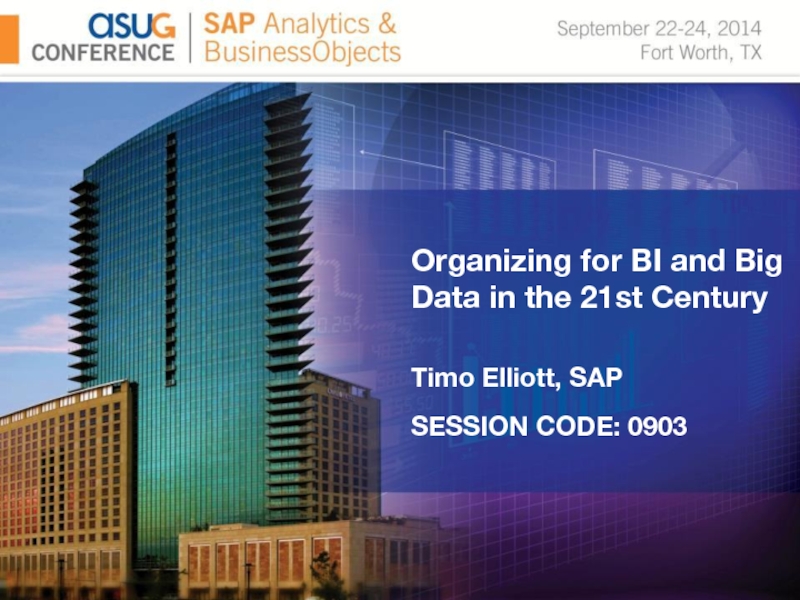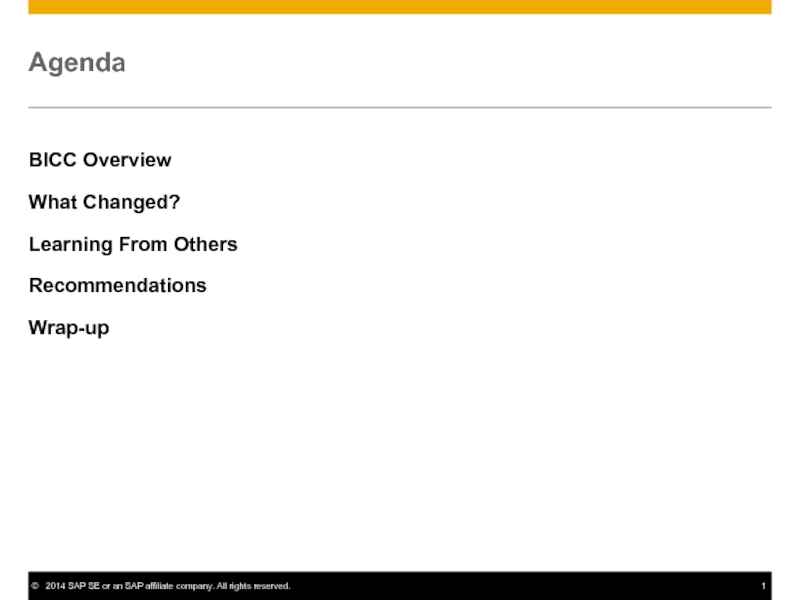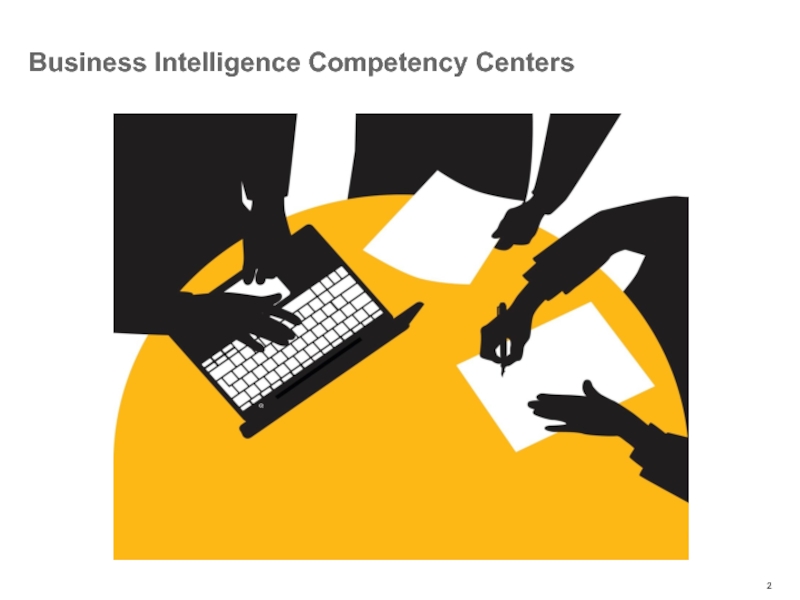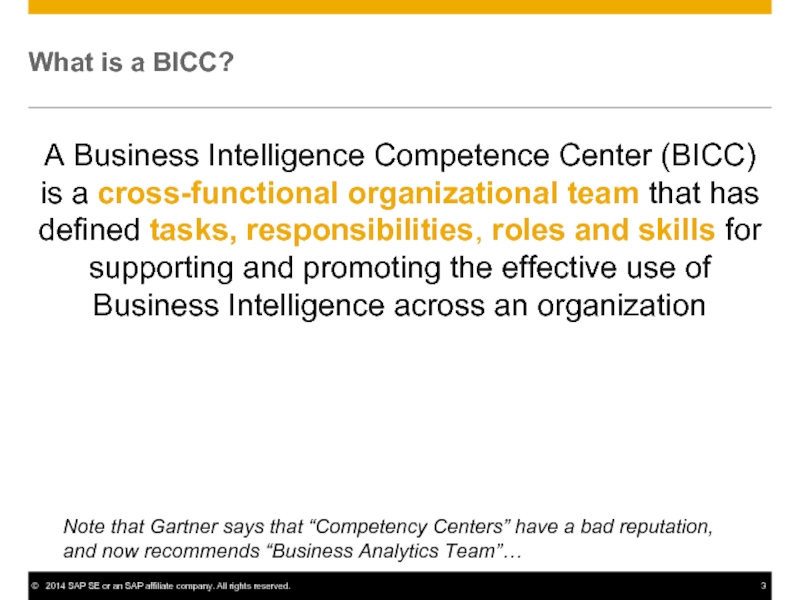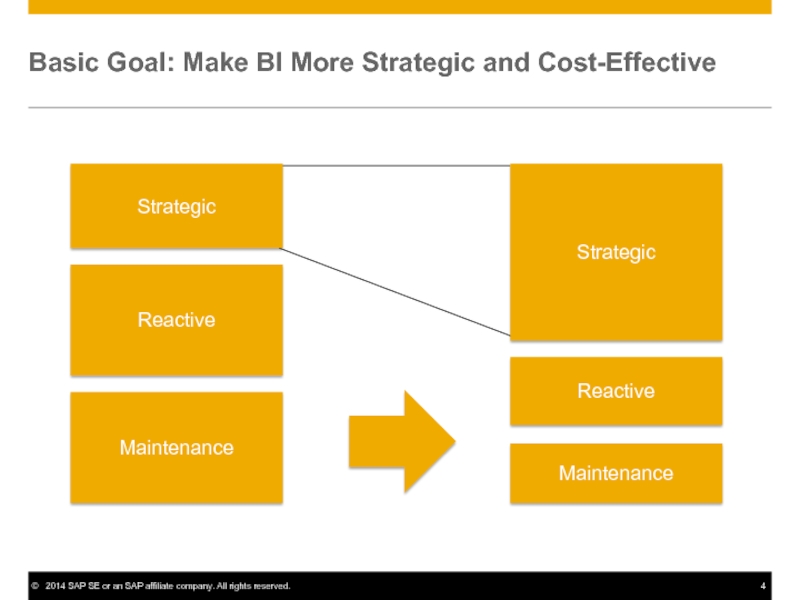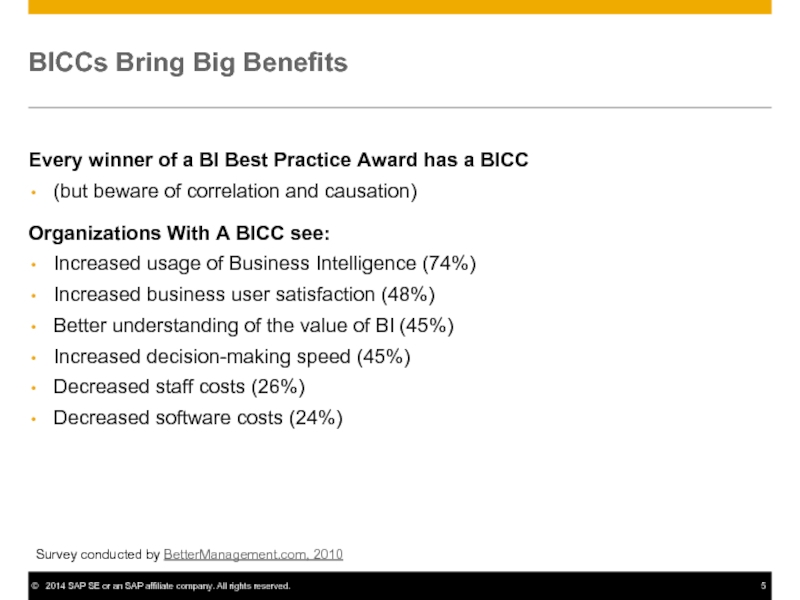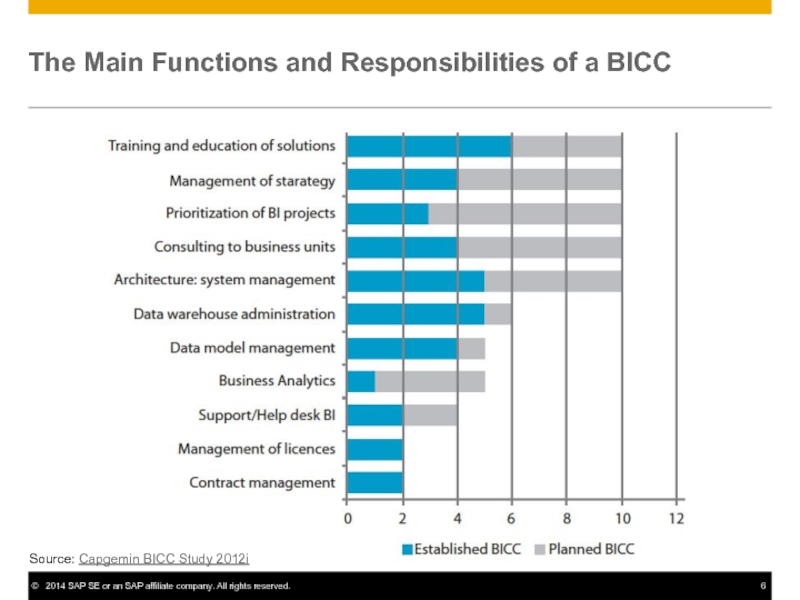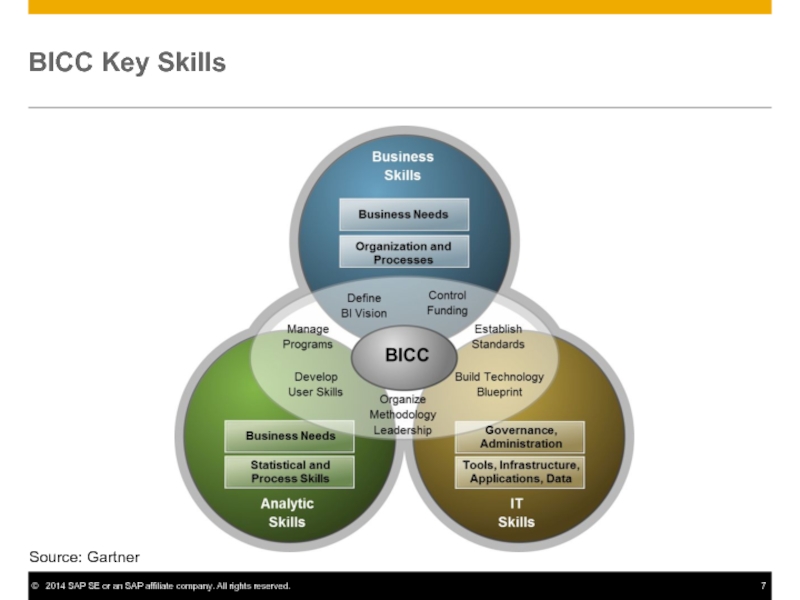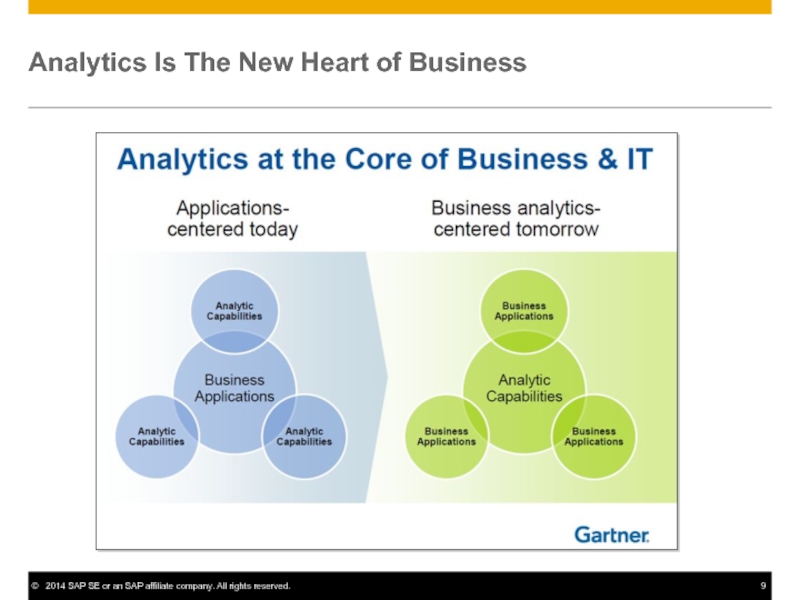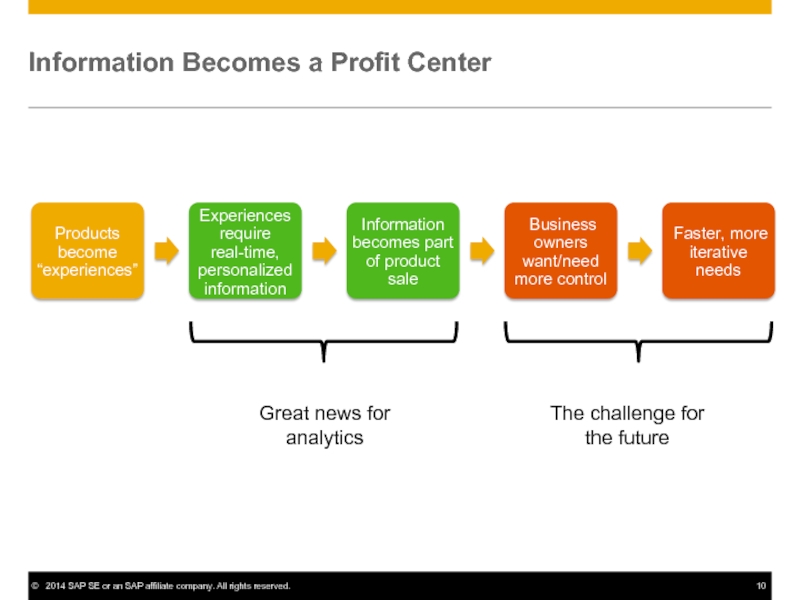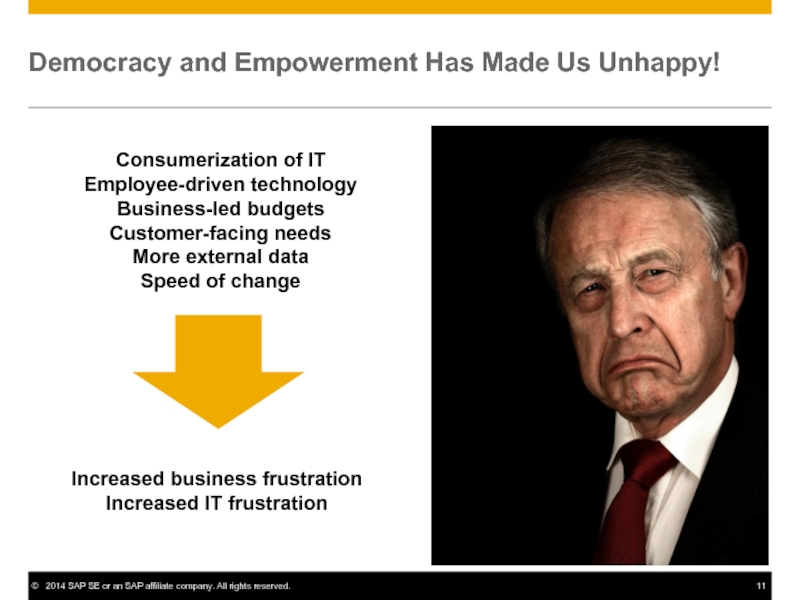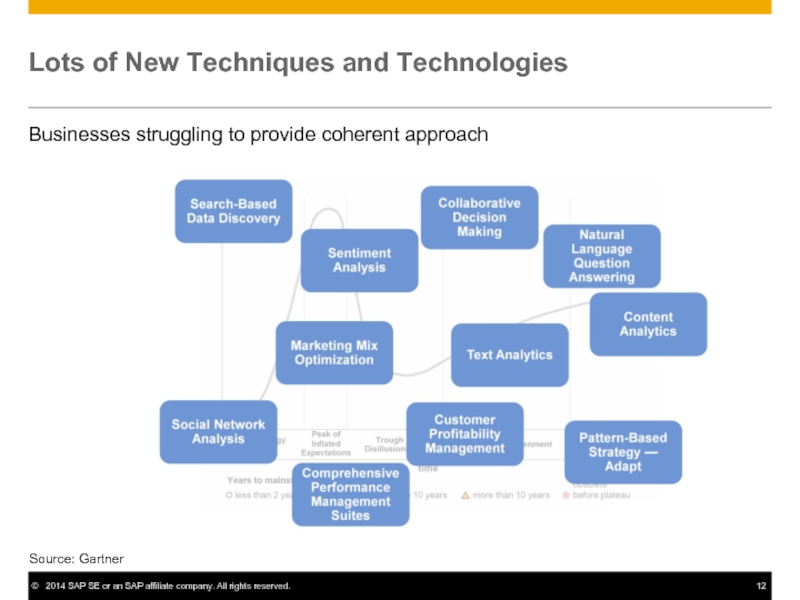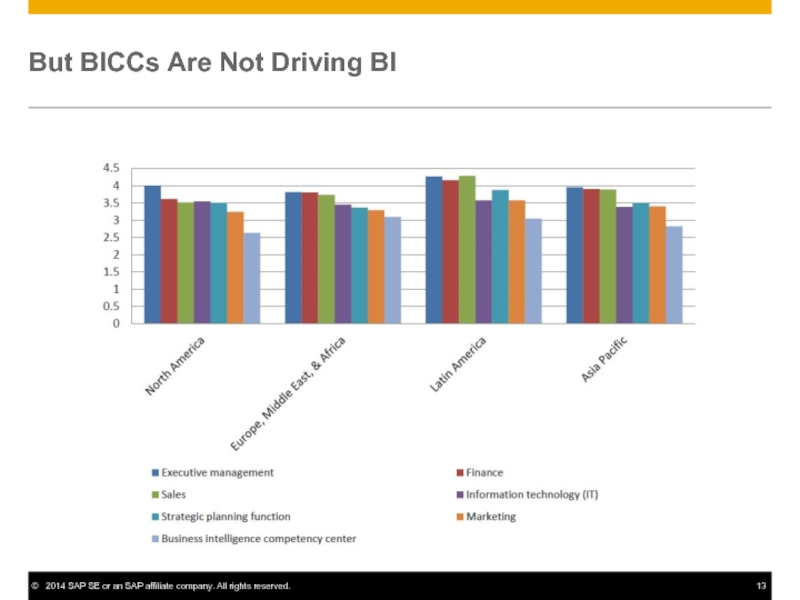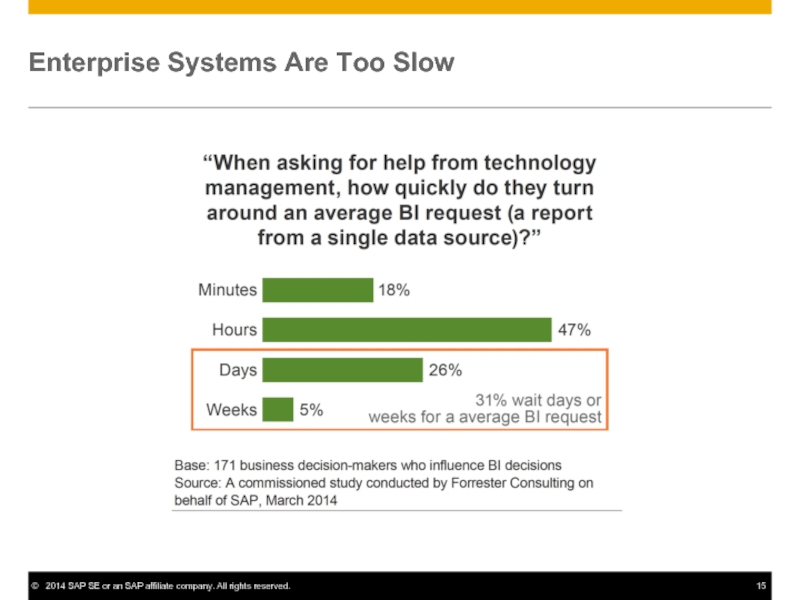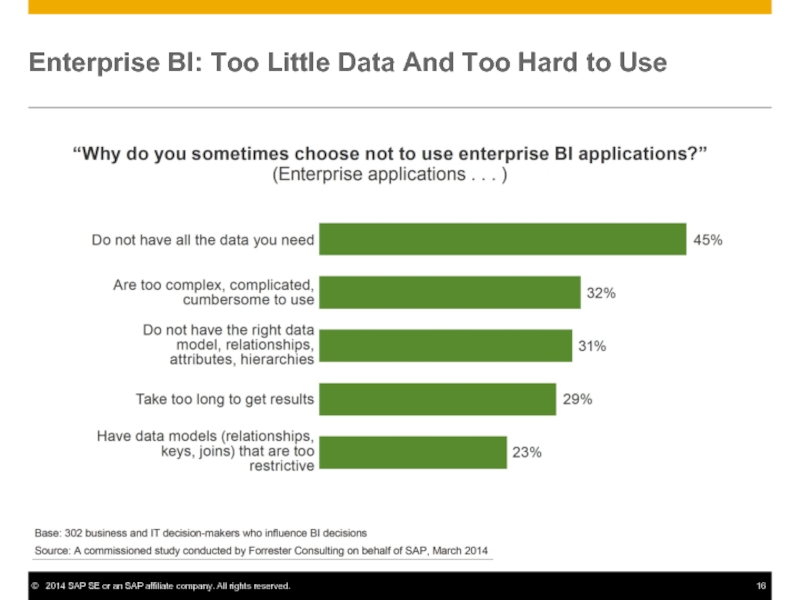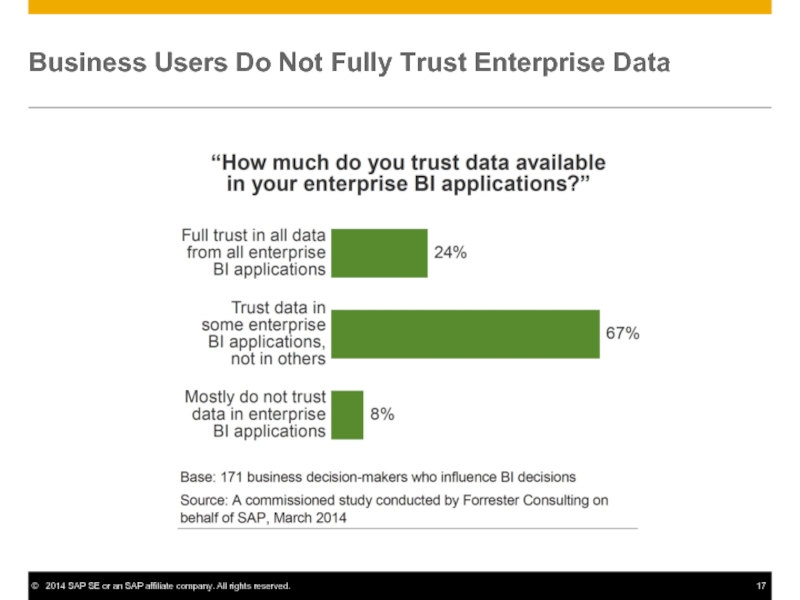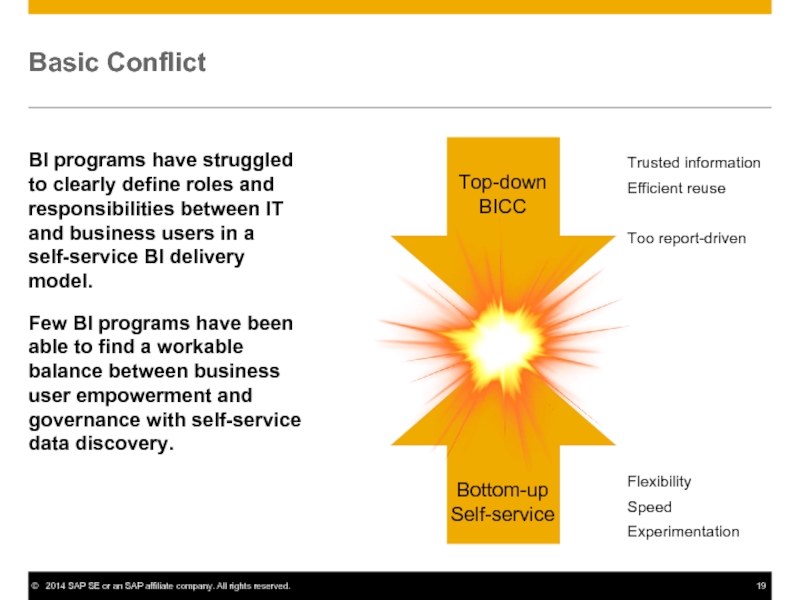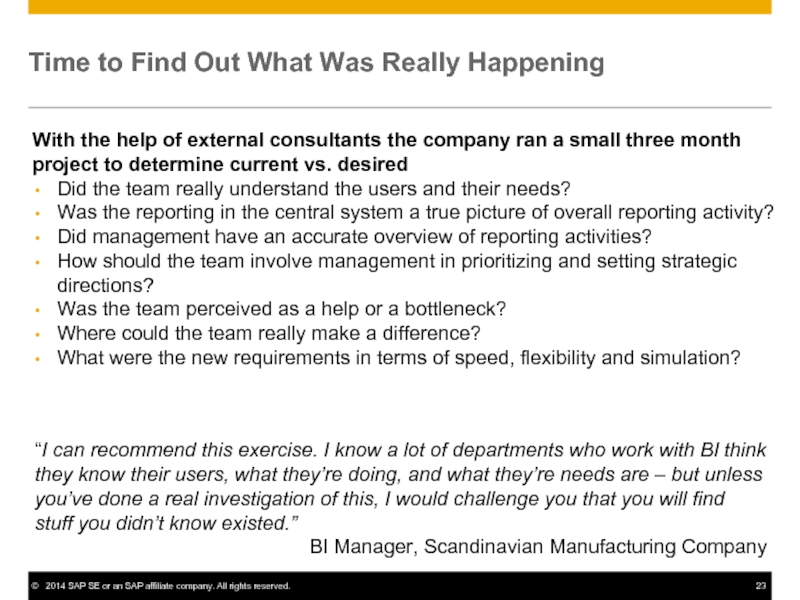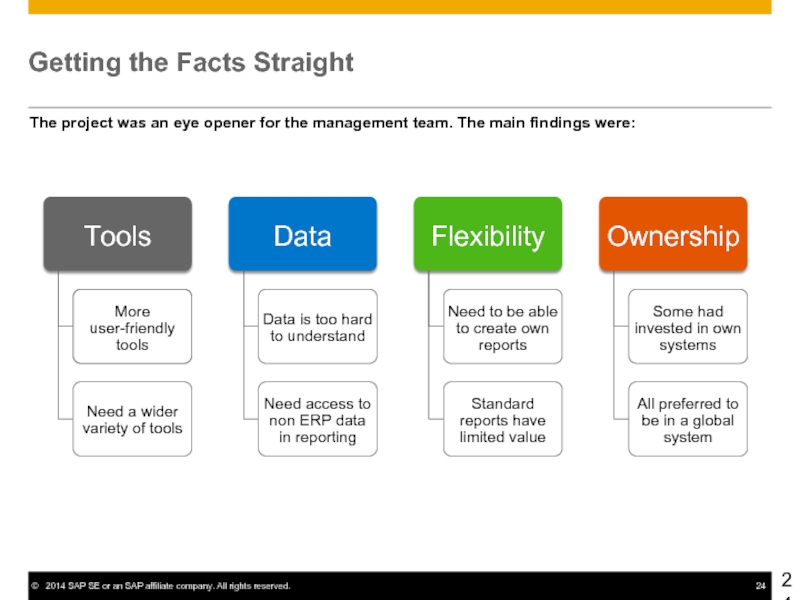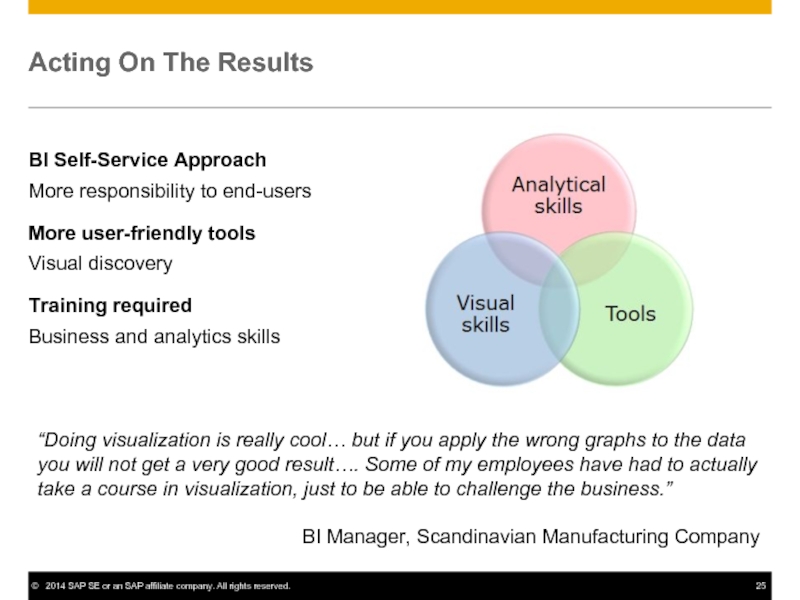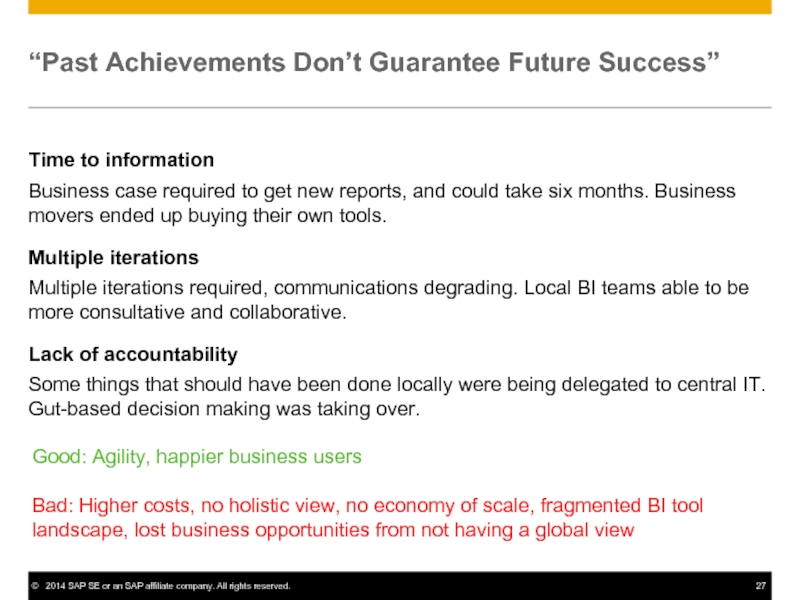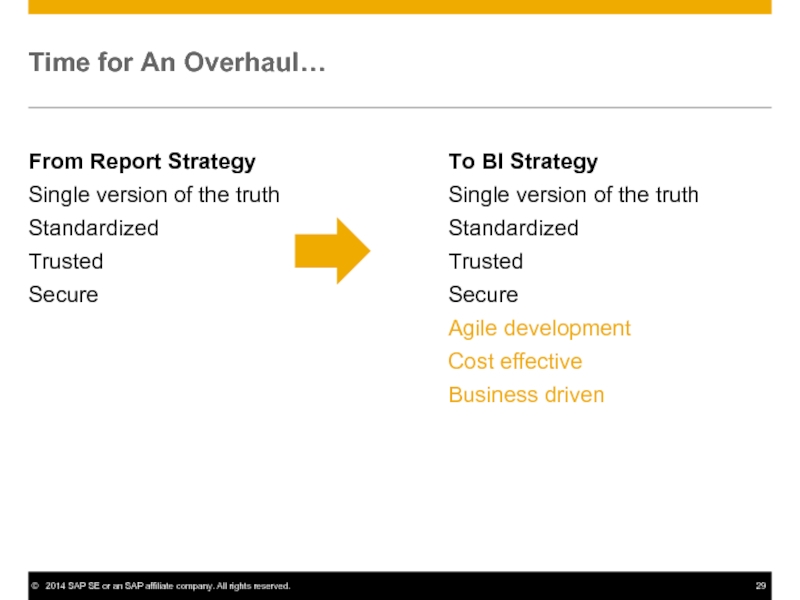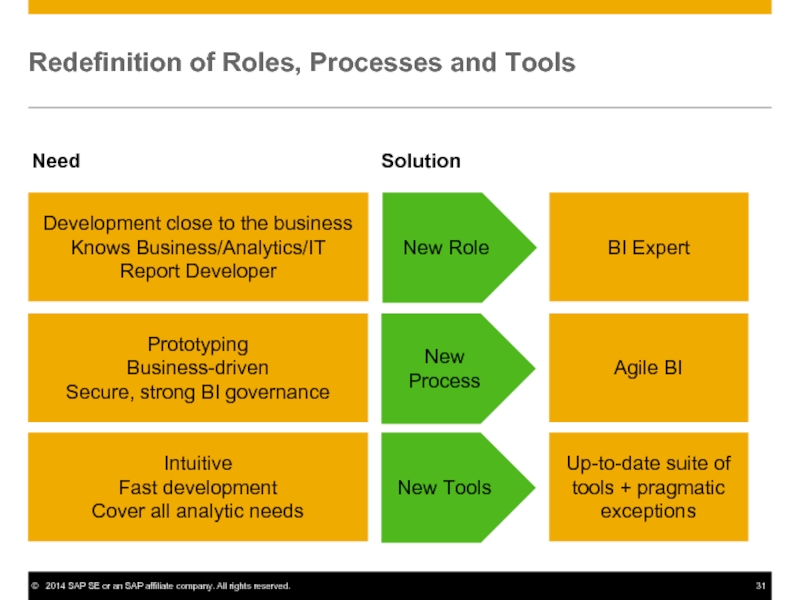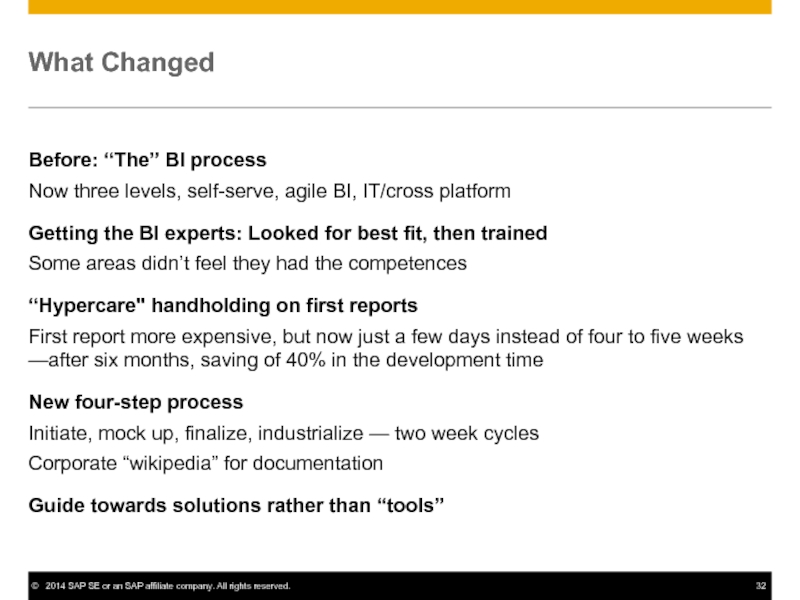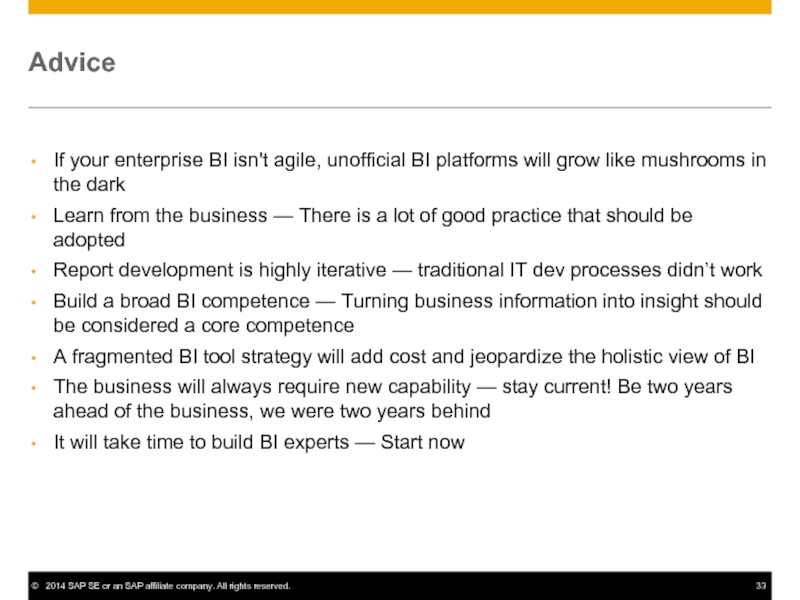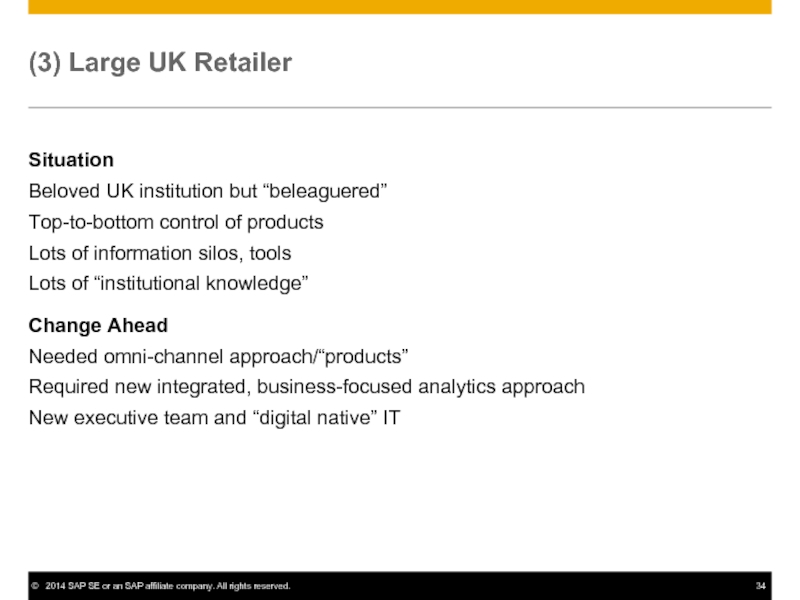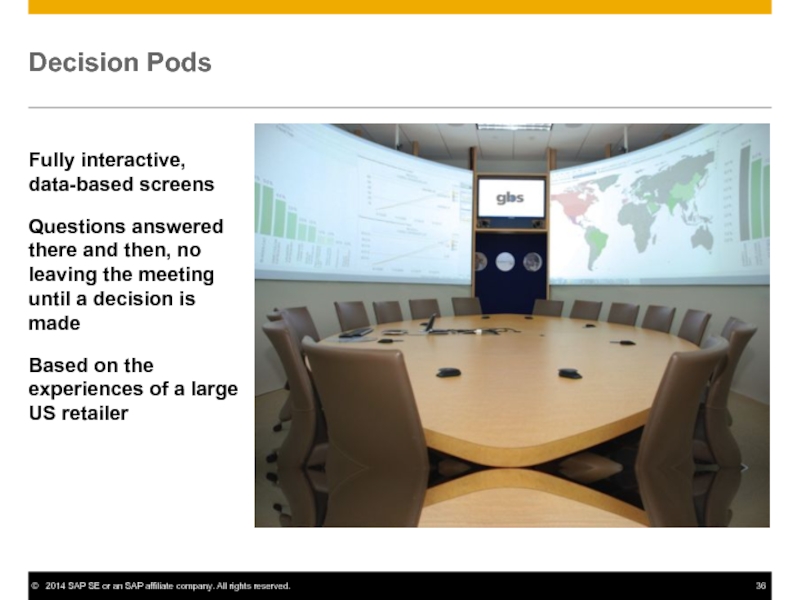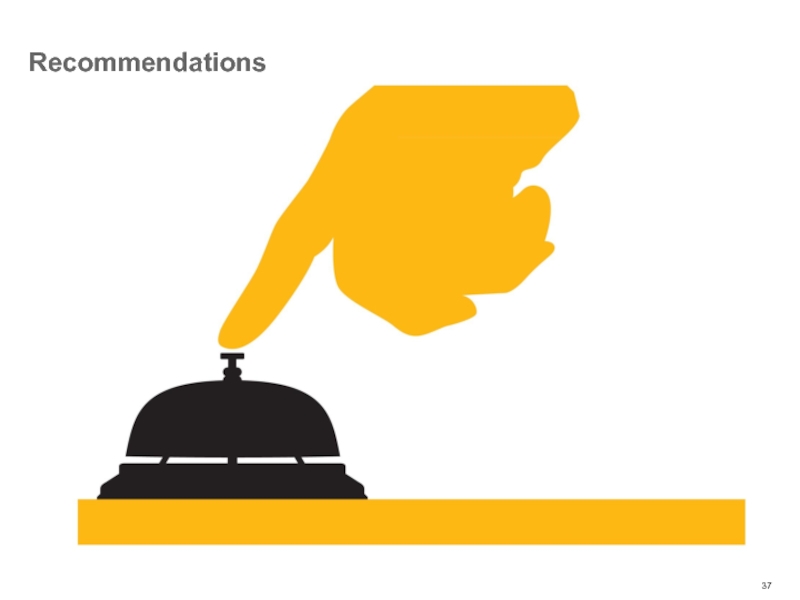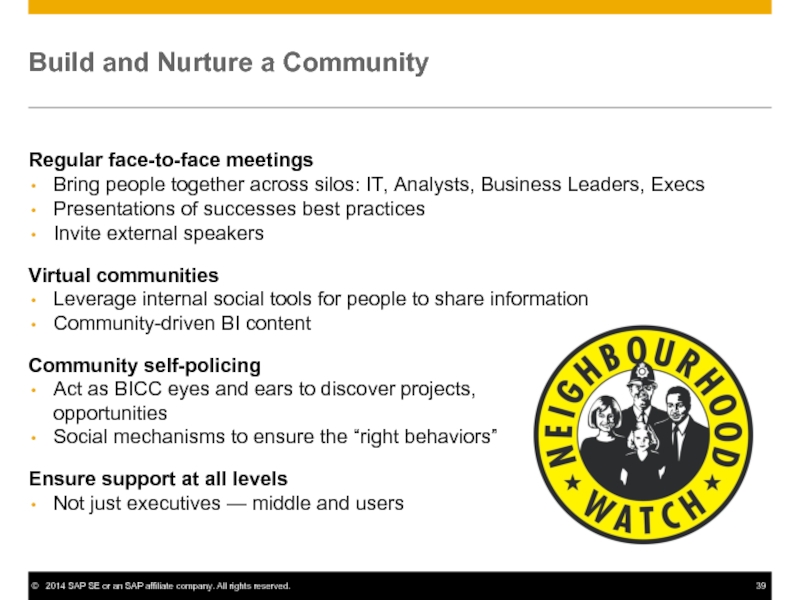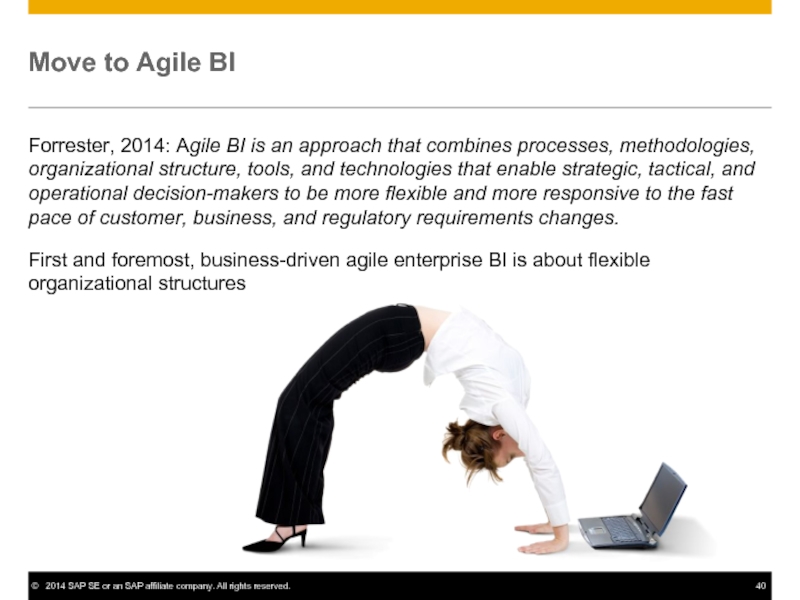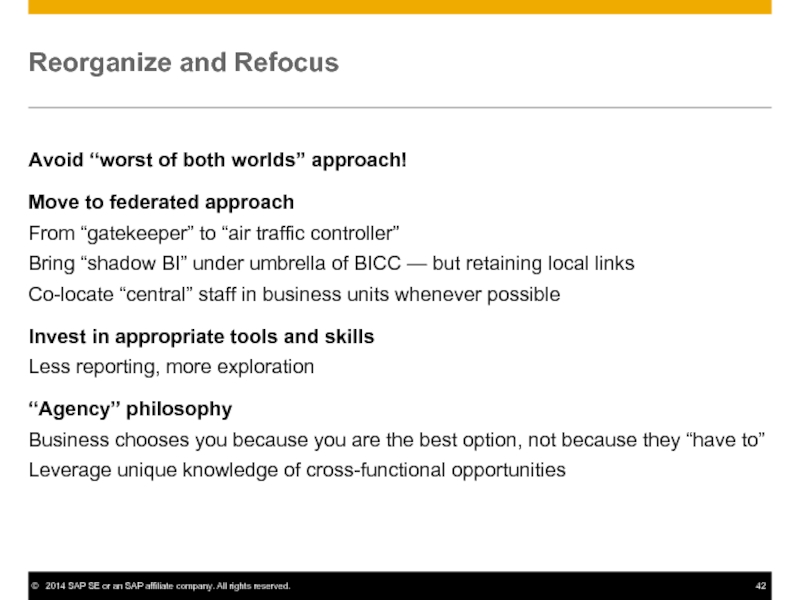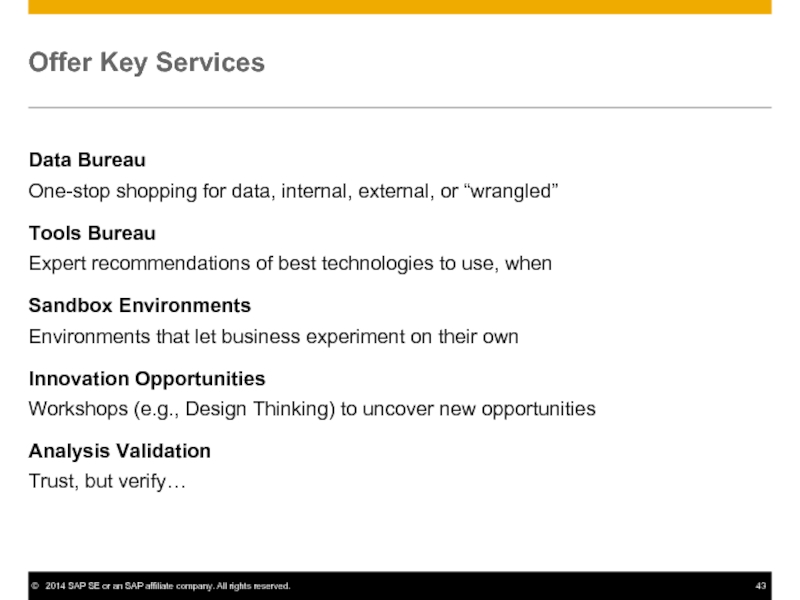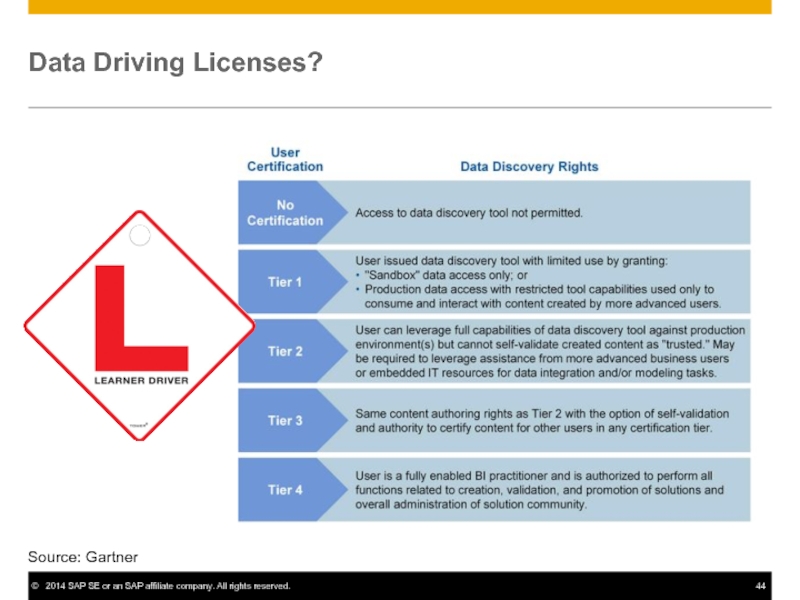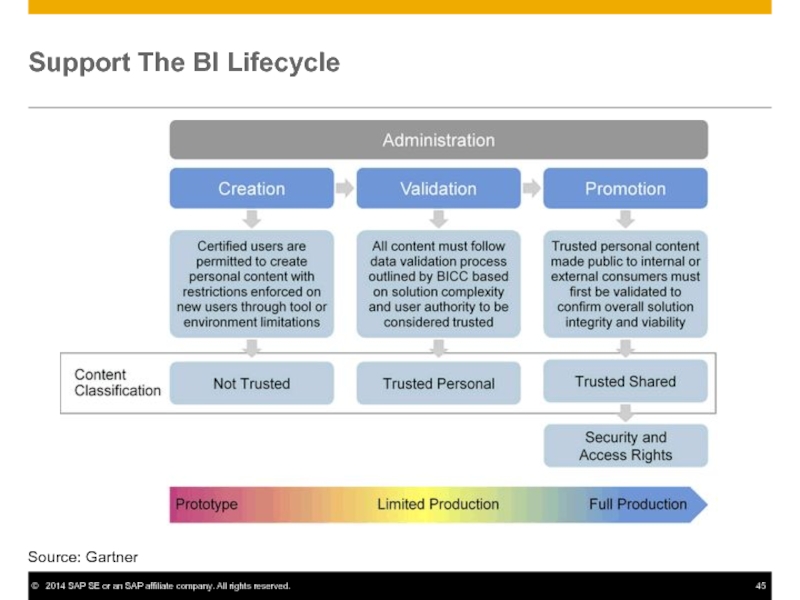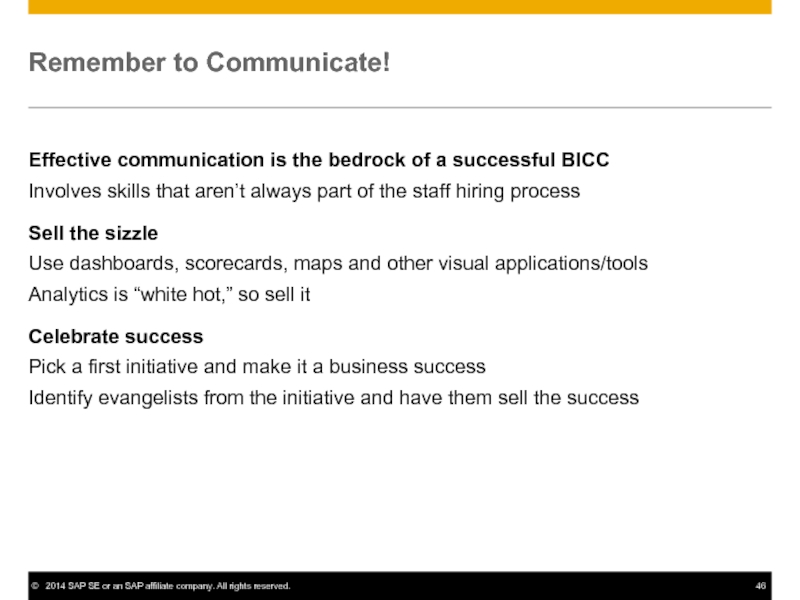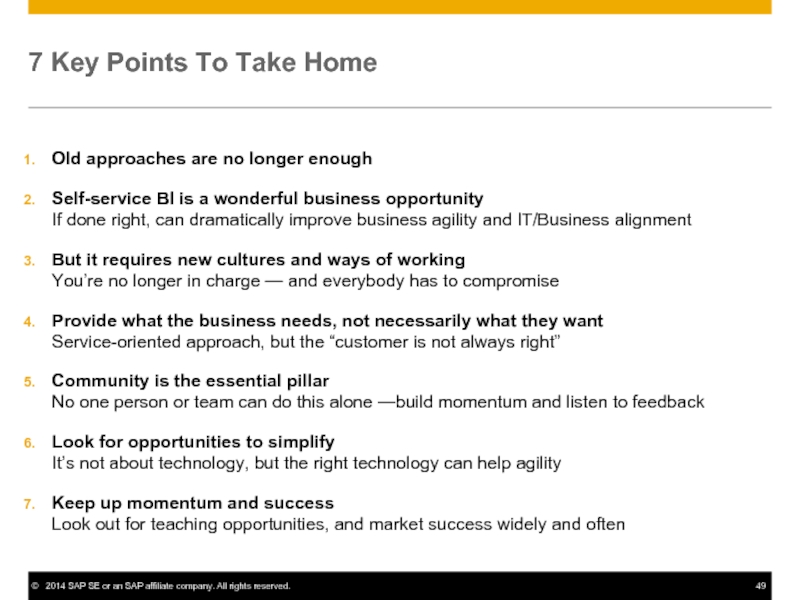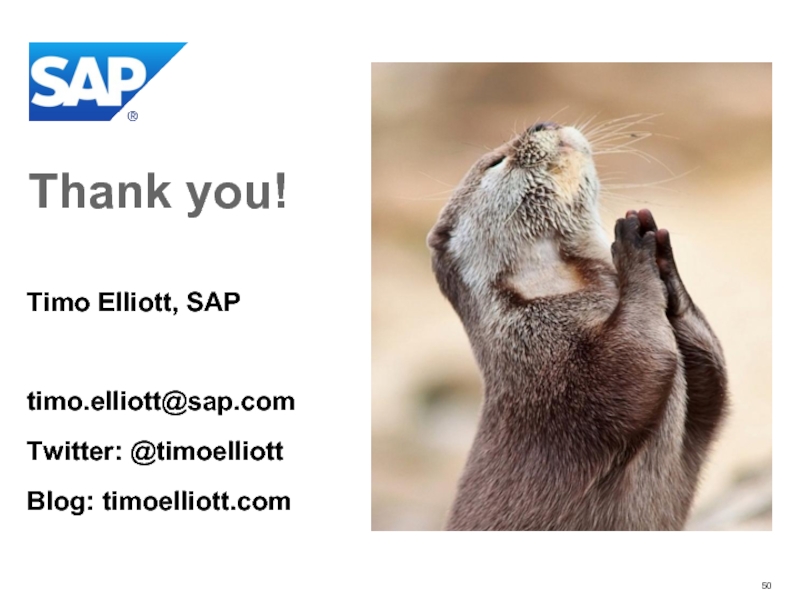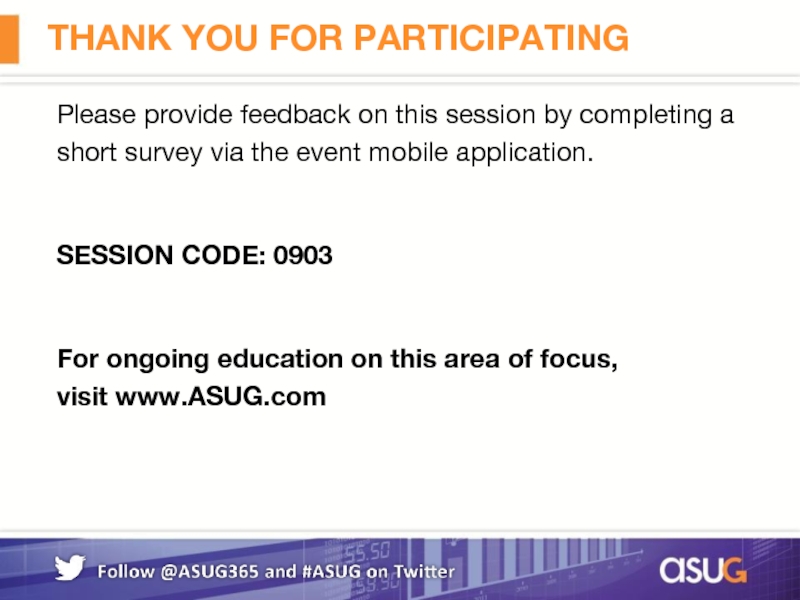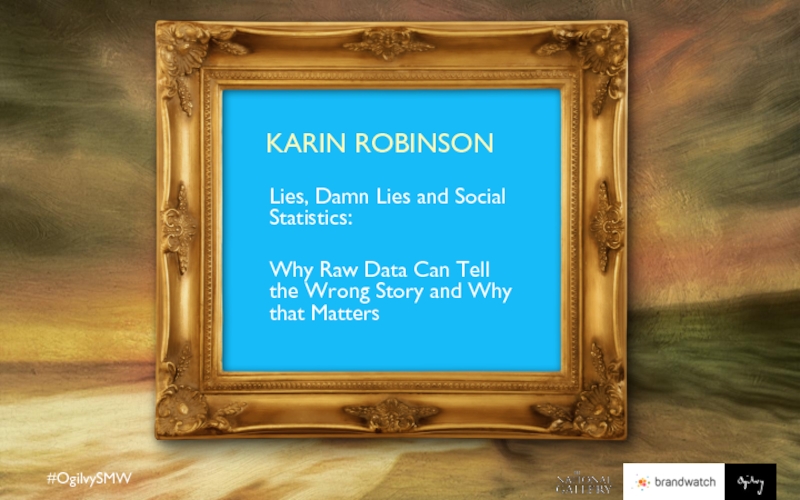- Главная
- Разное
- Дизайн
- Бизнес и предпринимательство
- Аналитика
- Образование
- Развлечения
- Красота и здоровье
- Финансы
- Государство
- Путешествия
- Спорт
- Недвижимость
- Армия
- Графика
- Культурология
- Еда и кулинария
- Лингвистика
- Английский язык
- Астрономия
- Алгебра
- Биология
- География
- Детские презентации
- Информатика
- История
- Литература
- Маркетинг
- Математика
- Медицина
- Менеджмент
- Музыка
- МХК
- Немецкий язык
- ОБЖ
- Обществознание
- Окружающий мир
- Педагогика
- Русский язык
- Технология
- Физика
- Философия
- Химия
- Шаблоны, картинки для презентаций
- Экология
- Экономика
- Юриспруденция
Organizing for BI and Big Data in the 21st Century Timo Elliott, SAP SESSION CODE: 0903 презентация
Содержание
- 1. Organizing for BI and Big Data in the 21st Century Timo Elliott, SAP SESSION CODE: 0903
- 2. Agenda BICC Overview What Changed? Learning From Others Recommendations Wrap-up
- 3. Business Intelligence Competency Centers
- 4. What is a BICC? A Business Intelligence
- 5. Basic Goal: Make BI More Strategic and Cost-Effective Reactive Maintenance Strategic Reactive Maintenance Strategic
- 6. BICCs Bring Big Benefits Every winner of
- 7. The Main Functions and Responsibilities of a BICC Source: Capgemin BICC Study 2012i
- 8. BICC Key Skills Source: Gartner
- 9. What Changed?
- 10. Analytics Is The New Heart of Business
- 11. Information Becomes a Profit Center
- 12. Democracy and Empowerment Has Made Us Unhappy!
- 13. Lots of New Techniques and Technologies Businesses struggling to provide coherent approach Source: Gartner
- 14. But BICCs Are Not Driving BI
- 15. The Majority of Data Users Need Isn’t
- 16. Enterprise Systems Are Too Slow
- 17. Enterprise BI: Too Little Data And Too Hard to Use
- 18. Business Users Do Not Fully Trust Enterprise Data
- 19. So Users Turn To Their Own Systems
- 20. Basic Conflict BI programs have struggled to
- 21. Learning From Others
- 22. (1) Scandinavian Consumer Manufacturing Co. The
- 23. A Change in User Profiles and Patterns
- 24. Time to Find Out What Was Really
- 25. Getting the Facts Straight The project was
- 26. Acting On The Results BI Self-Service Approach
- 27. (2) European Consumer Goods Packaging Company Had
- 28. “Past Achievements Don’t Guarantee Future Success” Time
- 29. Making It Agile How to make an
- 30. Time for An Overhaul… From Report Strategy
- 31. Decentralization of Reporting Data warehouse centralized, but all report development local
- 32. Redefinition of Roles, Processes and Tools Development
- 33. What Changed Before: “The” BI process Now
- 34. Advice If your enterprise BI isn't agile,
- 35. (3) Large UK Retailer Situation Beloved UK
- 36. Launched New Analytics Approach Big kick-off meeting
- 37. Decision Pods Fully interactive, data-based screens Questions
- 38. Recommendations
- 39. It’s All About the Relationship Any CIO’s
- 40. Build and Nurture a Community Regular face-to-face
- 41. Move to Agile BI Forrester, 2014: Agile
- 42. Inspiration From The “Agile Manifesto” The highest
- 43. Reorganize and Refocus Avoid “worst of both
- 44. Offer Key Services Data Bureau One-stop shopping
- 45. Data Driving Licenses? Source: Gartner
- 46. Support The BI Lifecycle Source: Gartner
- 47. Remember to Communicate! Effective communication is the
- 48. Wrap-up
- 49. Useful Resources Barc Collective Insight
- 50. 7 Key Points To Take Home
- 51. Thank you! Timo Elliott, SAP timo.elliott@sap.com Twitter: @timoelliott Blog: timoelliott.com
- 52. Please provide feedback on this session by
Слайд 4What is a BICC?
A Business Intelligence Competence Center (BICC) is a
Note that Gartner says that “Competency Centers” have a bad reputation, and now recommends “Business Analytics Team”…
Слайд 5Basic Goal: Make BI More Strategic and Cost-Effective
Reactive
Maintenance
Strategic
Reactive
Maintenance
Strategic
Слайд 6BICCs Bring Big Benefits
Every winner of a BI Best Practice Award
(but beware of correlation and causation)
Organizations With A BICC see:
Increased usage of Business Intelligence (74%)
Increased business user satisfaction (48%)
Better understanding of the value of BI (45%)
Increased decision-making speed (45%)
Decreased staff costs (26%)
Decreased software costs (24%)
Survey conducted by BetterManagement.com, 2010
Слайд 12Democracy and Empowerment Has Made Us Unhappy!
Consumerization of IT
Employee-driven technology
Business-led budgets
Customer-facing
More external data
Speed of change
Increased business frustration
Increased IT frustration
Слайд 13Lots of New Techniques and Technologies
Businesses struggling to provide coherent approach
Source:
Слайд 15The Majority of Data Users Need Isn’t In The System
“We found,
An astonishingly miniscule 2% of business decision-makers reported using solely enterprise BI applications.
This is undoubtedly connected to 76% of business respondents indicating they continue to resort to spreadsheets and other homegrown BI applications to analyze BI data. ”
Source: Forrester
Слайд 19So Users Turn To Their Own Systems
40% are using an equal
Слайд 20Basic Conflict
BI programs have struggled to clearly define roles and responsibilities
Few BI programs have been able to find a workable balance between business user empowerment and governance with self-service data discovery.
Top-down
BICC
Bottom-up
Self-service
Trusted information
Efficient reuse
Too report-driven
Flexibility
Speed
Experimentation
Слайд 22(1) Scandinavian Consumer Manufacturing Co.
The company deployed a first Global BI
Слайд 23A Change in User Profiles and Patterns
Over a period of 7
The shifts seem to happen with shorter and shorter intervals
Слайд 24Time to Find Out What Was Really Happening
With the help of
Did the team really understand the users and their needs?
Was the reporting in the central system a true picture of overall reporting activity?
Did management have an accurate overview of reporting activities?
How should the team involve management in prioritizing and setting strategic directions?
Was the team perceived as a help or a bottleneck?
Where could the team really make a difference?
What were the new requirements in terms of speed, flexibility and simulation?
“I can recommend this exercise. I know a lot of departments who work with BI think they know their users, what they’re doing, and what they’re needs are – but unless you’ve done a real investigation of this, I would challenge you that you will find stuff you didn’t know existed.”
BI Manager, Scandinavian Manufacturing Company
Слайд 25Getting the Facts Straight
The project was an eye opener for the
Слайд 26Acting On The Results
BI Self-Service Approach
More responsibility to end-users
More user-friendly tools
Visual
Training required
Business and analytics skills
“Doing visualization is really cool… but if you apply the wrong graphs to the data you will not get a very good result…. Some of my employees have had to actually take a course in visualization, just to be able to challenge the business.”
BI Manager, Scandinavian Manufacturing Company
Слайд 27(2) European Consumer Goods Packaging Company
Had Created The “Perfect Giant” of
Business Intelligence was:
Standardized
Repeatable
Clearly understood across the company
Regular, well-communicated releases
Jointly agreed between Business and IT
Facilitates the business areas planning and scheduling of report requests
A steering group of senior management
Majority business leaders with strong representation from IT
Clear measurements to follow up performance
Usage and user feedback
Слайд 28“Past Achievements Don’t Guarantee Future Success”
Time to information
Business case required
Multiple iterations
Multiple iterations required, communications degrading. Local BI teams able to be more consultative and collaborative.
Lack of accountability
Some things that should have been done locally were being delegated to central IT. Gut-based decision making was taking over.
Good: Agility, happier business users
Bad: Higher costs, no holistic view, no economy of scale, fragmented BI tool landscape, lost business opportunities from not having a global view
Слайд 29Making It Agile
How to make an Ocean liner perform as a
Moving to an agile strategy
Learn from the business. BI is something that brings up emotions. Found a lot of good practice in the business as well as bad.
The unofficial BI was more agile and more cost-efficient: Creating the reports close to the action, leaner process, no handovers, more niche tools that met their requirements.
Had to find a new balance between control and autonomy/freedom.
Слайд 30Time for An Overhaul…
From Report Strategy
Single version of the truth
Standardized
Trusted
Secure
To BI
Single version of the truth
Standardized
Trusted
Secure
Agile development
Cost effective
Business driven
Слайд 32Redefinition of Roles, Processes and Tools
Development close to the business
Knows Business/Analytics/IT
Report
Prototyping
Business-driven
Secure, strong BI governance
Intuitive
Fast development
Cover all analytic needs
BI Expert
Agile BI
Up-to-date suite of tools + pragmatic exceptions
New Role
New Process
New Tools
Need
Solution
Слайд 33What Changed
Before: “The” BI process
Now three levels, self-serve, agile BI, IT/cross
Getting the BI experts: Looked for best fit, then trained
Some areas didn’t feel they had the competences
“Hypercare" handholding on first reports
First report more expensive, but now just a few days instead of four to five weeks —after six months, saving of 40% in the development time
New four-step process
Initiate, mock up, finalize, industrialize — two week cycles
Corporate “wikipedia” for documentation
Guide towards solutions rather than “tools”
Слайд 34Advice
If your enterprise BI isn't agile, unofficial BI platforms will grow
Learn from the business — There is a lot of good practice that should be adopted
Report development is highly iterative — traditional IT dev processes didn’t work
Build a broad BI competence — Turning business information into insight should be considered a core competence
A fragmented BI tool strategy will add cost and jeopardize the holistic view of BI
The business will always require new capability — stay current! Be two years ahead of the business, we were two years behind
It will take time to build BI experts — Start now
Слайд 35(3) Large UK Retailer
Situation
Beloved UK institution but “beleaguered”
Top-to-bottom control of products
Lots
Lots of “institutional knowledge”
Change Ahead
Needed omni-channel approach/“products”
Required new integrated, business-focused analytics approach
New executive team and “digital native” IT
Слайд 36Launched New Analytics Approach
Big kick-off meeting
Analysts, IT, execs, outside experts
All areas
Tool independent
Launched new “service bureau” approach
Strong executive support
Analytics driven locally, best-practice shared centrally
“Own the problem, not the solution” (“Can we access this tool, please?”)
Collection of “agile services”
Community-driven, using internal social networking
Слайд 37Decision Pods
Fully interactive, data-based screens
Questions answered there and then, no leaving
Based on the experiences of a large US retailer
Слайд 39It’s All About the Relationship
Any CIO’s dream is to have a
Instead of a scenario in which Business and IT play separate, traditional provider-versus-user roles everybody has to combine efforts to jointly explore and learn — and everybody has to compromise!
Слайд 40Build and Nurture a Community
Regular face-to-face meetings
Bring people together across silos:
Presentations of successes best practices
Invite external speakers
Virtual communities
Leverage internal social tools for people to share information
Community-driven BI content
Community self-policing
Act as BICC eyes and ears to discover projects, opportunities
Social mechanisms to ensure the “right behaviors”
Ensure support at all levels
Not just executives — middle and users
Слайд 41Move to Agile BI
Forrester, 2014: Agile BI is an approach that
First and foremost, business-driven agile enterprise BI is about flexible organizational structures
Слайд 42Inspiration From The “Agile Manifesto”
The highest priority is to satisfy the
Welcome changing requirements, even late in development. Agile processes harness change for competitive advantage.
Deliver working projects frequently, from a couple of weeks to a couple of months, with a preference to the shorter timescale.
Business people and analytics staff must work together daily throughout the project.
Build projects around motivated individuals. Give them the environment and support they need, and trust them to get the job done.
The most efficient and effective method of conveying information to and within a development team is face-to-face conversation.
Delivered, used analytics is the primary measure of progress.
Agile processes promote sustainable development. The sponsors, developers and users should be able to maintain a constant pace indefinitely.
Continuous attention to technical excellence and good design enhances agility.
Simplicity — the art of maximizing the amount of work not done — is essential.
The best architectures, requirements and designs emerge from self-organizing teams.
At regular intervals, the team reflects on how to become more effective, then tunes and adjusts its behavior accordingly.
Adapted from: http://agilemanifesto.org/
Слайд 43Reorganize and Refocus
Avoid “worst of both worlds” approach!
Move to federated approach
From
Bring “shadow BI” under umbrella of BICC — but retaining local links
Co-locate “central” staff in business units whenever possible
Invest in appropriate tools and skills
Less reporting, more exploration
“Agency” philosophy
Business chooses you because you are the best option, not because they “have to”
Leverage unique knowledge of cross-functional opportunities
Слайд 44Offer Key Services
Data Bureau
One-stop shopping for data, internal, external, or “wrangled”
Tools
Expert recommendations of best technologies to use, when
Sandbox Environments
Environments that let business experiment on their own
Innovation Opportunities
Workshops (e.g., Design Thinking) to uncover new opportunities
Analysis Validation
Trust, but verify…
Слайд 47Remember to Communicate!
Effective communication is the bedrock of a successful BICC
Involves
Sell the sizzle
Use dashboards, scorecards, maps and other visual applications/tools
Analytics is “white hot,” so sell it
Celebrate success
Pick a first initiative and make it a business success
Identify evangelists from the initiative and have them sell the success
Слайд 49Useful Resources
Barc Collective Insight white paper
SAP BICC Playlist on YouTube: Link
SAP
BI News: www.sap.com/BINews
Blogs on BI Strategy
http://scn.sap.com/docs/DOC-30479
http://scn.sap.com/docs/DOC-30480
http://scn.sap.com/community/business-intelligence/blog/2012/12/07/bi-strategy-bicc-a-key-element-to-your-bi-program
http://scn.sap.com/community/business-intelligence/blog/2012/11/07/bi-strategy-bi-competency-centers-take-center-stage-again
http://blogs.sap.com/analytics/2013/03/27/driving-value-from-your-business-intelligence-program-define-track-and-measure-success/
Слайд 507 Key Points To Take Home
Old approaches are no longer
Self-service BI is a wonderful business opportunity
If done right, can dramatically improve business agility and IT/Business alignment
But it requires new cultures and ways of working
You’re no longer in charge — and everybody has to compromise
Provide what the business needs, not necessarily what they want
Service-oriented approach, but the “customer is not always right”
Community is the essential pillar
No one person or team can do this alone —build momentum and listen to feedback
Look for opportunities to simplify
It’s not about technology, but the right technology can help agility
Keep up momentum and success
Look out for teaching opportunities, and market success widely and often
Слайд 52Please provide feedback on this session by completing a short survey
SESSION CODE: 0903
For ongoing education on this area of focus, visit www.ASUG.com
THANK YOU FOR PARTICIPATING
